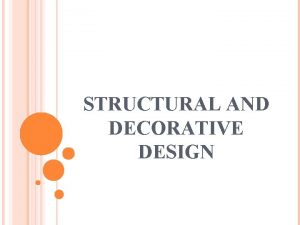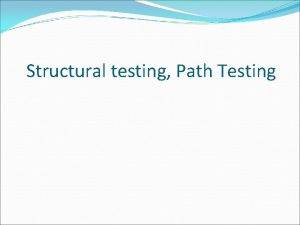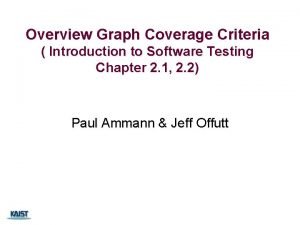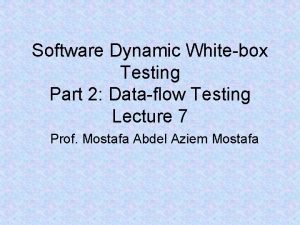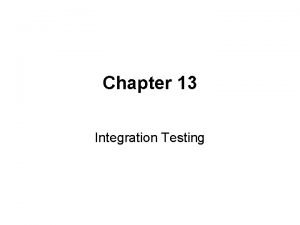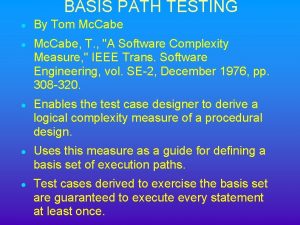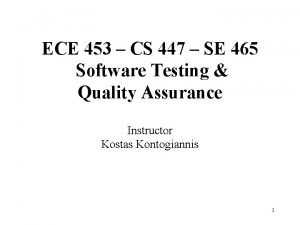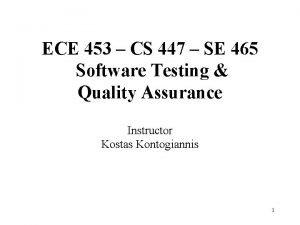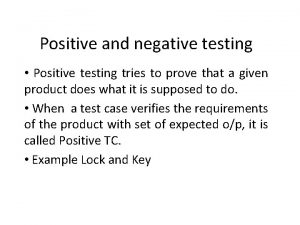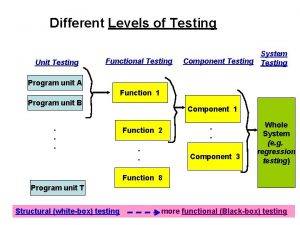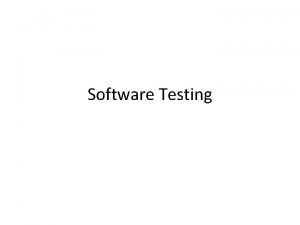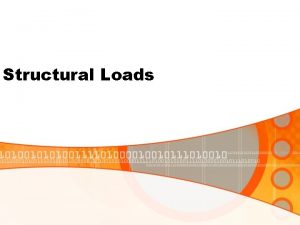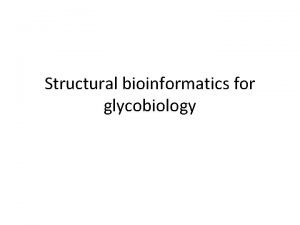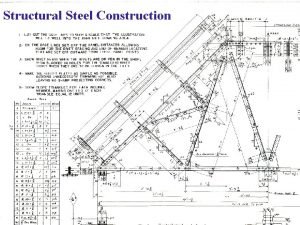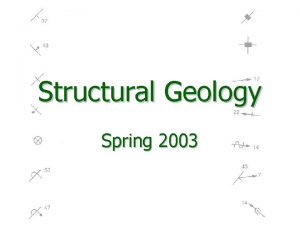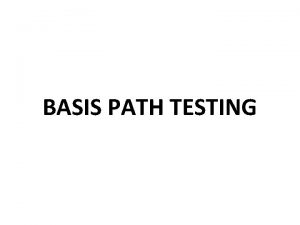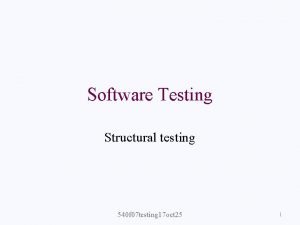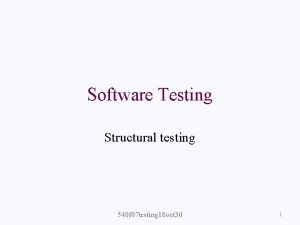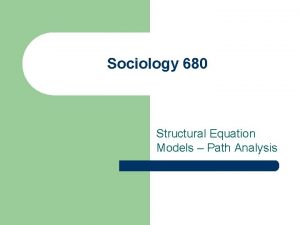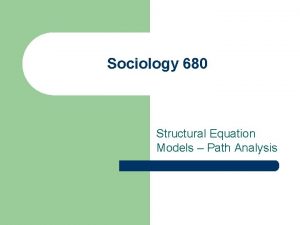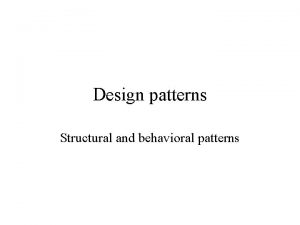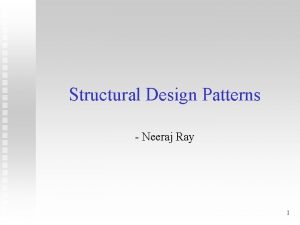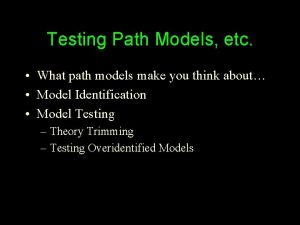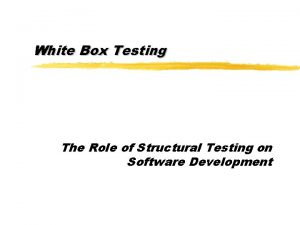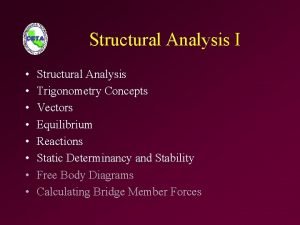Path testing Path testing is a design structural






























- Slides: 30

Path testing • Path testing is a “design structural testing” in that it is based on detailed design & the source code of the program to be tested. • The methodology uses the graphical representation of the source code – Thus it is very much “control flow” or “path” oriented • This methodology has been available since the mid-1970’s and is an important White Box testing technique

Transforming Code to Diagram • In early chapter (chapter 4) on graph theory, we mentioned condensation graph as a graph that was derived by “condensing” a component (or set of code) into a node as a way to simplify the graphical diagram of source code. • Here we will : – assume that we have a condensed graph and discuss path analysis

Path Analysis • Why path analysis for test case design? – Provides a systematic methodology of White Box testing. • Reproducible • Traceable • Countable Reasons similar to why document test cases • What is path analysis? – Analyzes the number of paths that exist in the system – Facilitates the decision process of how many paths to include in the test Path, as previously defined in Graph Theory, is a sequence of connected nodes

Linearly Independent Path • A path through the system is Linearly Independent** from other paths only if it includes some segment or edge that is not covered in the other paths. - The statements are represented by the rectangular and diamond blocks (nodes). - The segments between the blocks are the edges, labeled with numbered circles. S 1 1 2 C 1 4 S 2 3 S 3 Path 1 : S 1 – C 1 – S 3 Path 2 : S 1 – C 1 – S 2 – S 3 OR Path 1: edges (1, 4) Path 2: edges (1, 2, 3) Path 1 and Path 2 are linearly independent because each includes some edge that is not included in the others. (note: not necessarily nodes) ** This definition will require more explanation later.

Another Example of Linearly Independent Paths S 1 1 C 1 2 S 2 8 9 Path 1: Path 2: Path 3: Path 4: 10 Note that these are all linearly independent 5 C 2 3 S 3 6 C 3 7 S 5 4 S 4 edges (1, 2, 8) edges (1, 5, 3, 9) edges (1, 5, 6, 4, 10) edges (1, 5, 6, 7)

Statement Coverage Method • Count all the linearly independent paths • Pick the minimum number of linearly independent paths that will include all the statements (nodes) (S’s and C’s in the diagram) S 1 Path 1 : S 1 – C 1 – S 3 : edges (1, 4) Path 2 : S 1 – C 1 – S 2 – S 3 : edges (1, 2. 3 ) 1 2 C 1 4 S 2 3 S 3 Are both Path 1 and Path 2 needed to cover all the statements: (S 1, C 1, S 2, S 3) ? What would you say?

Another Example of Statement Coverage S 1 1 C 1 2 S 2 8 The 4 Linearly Independent Paths Covers: 5 C 2 3 S 3 9 6 C 3 7 4 S 4 10 Path 1: includes S 1 -C 1 -S 2 -S 5 : edges (1, 2, 8) Path 2: includes S 1 -C 2 -S 3 -S 5 : edges ( 1, 5, 3, 9) Path 3: includes S 1 -C 2 -C 3 -S 4 -S 5 : edges (1, 5, 6, 4, 10) Path 4: includes S 1 -C 2 -C 3 -S 5 : edges (1, 5, 6, 7) S 5 For 100% Statement Coverage, all we need are 3 paths : Path 1, Path 2, and Path 3 to cover all the statements (S 1, C 1, S 2, C 2, S 3, C 3, S 4, S 5) - - - no need for Path 4 - - !!

Statement Coverage Now - - What do you think of a Software Company which boasts that they run every statement in the software before release? Try this on some students or other professors and see their reaction.

Branch Coverage Method (Also DD-Paths of our text book) 1. Identify all the decisions 2. Count all the branches from each of the decisions ( “out-degree” of the decision node) 3. Pick the minimum number of paths that will cover all the branches from the decisions.

Branch Coverage Method One decision C 1 : B 1 : Path 1 : C 1 – S 3 B 2 : Path 2 : C 1 – S 2 S 1 1 Branch 1 C 1 Branch 2 2 linearly independent paths cover : 2 4 S 2 3 B 1 : Path 1 : S 1 - C 1 – S 3 B 2 : Path 2 : S 1 - C 1 – S 2 – S 3 Are both Path 1 and Path 2 needed to cover Branch 1 and Branch 2 from C 1?

Another Example of Branch Coverage The 3 Decisions and the Branches: S 1 C 1: 1 C 1 2 S 2 - B 1 : C 1 - S 2 - B 2 : C 1 - C 2 8 C 2: - B 3 : C 2 – S 3 - B 4 : C 2 – C 3 5 C 2 3 S 3 9 - B 5 : C 3 – S 4 - B 6 ; C 3 – S 5 6 C 3 7 S 5 4 S 4 C 3: 10 The 4 Linearly Independent Paths Cover: Path 1: Path 2: Path 3: Path 4: includes S 1 -C 1 -S 2 -S 5 includes S 1 -C 2 -S 3 -S 5 includes S 1 -C 2 -C 3 -S 4 -S 5 includes S 1 -C 2 -C 3 -S 5 We need: Path 1 to cover B 1, Path 2 to cover B 2 and B 3, Path 3 to cover B 4 and B 5, Path 4 to cover B 6

Branch Coverage How do you feel about a Software Company who states that they test every branch in the Software before release? Does All Branch Coverage subsume All Statements Coverage?

Mc. Cabe’s Cyclomatic Number • Is there a way to know how many linearly independent paths exist? – Mc. Cabe’s Cyclomatic number which we used to study program complexity may be applied. There are 3 ways to get the Cyclomatic Complexity number from a flow diagram. • # of binary decisions + 1 • # of edges - # of nodes + 2 • # of closed regions + 1

Mc. Cabe’s Cyclomatic Complexity Number Earlier Example We know there are 2 linearly independent paths from before: Path 1 : C 1 – S 3 Path 2 : C 1 – S 2 – S 3 S 1 1 C 1 4 Mc. Cabe’s Cyclomatic Number: 2 Closed region S 2 3 S 3 a) # of binary decisions +1 = 1 +1 = 2 b) # of edges - # of nodes +2 = 4 -4+2 = 2 c) # of closed regions + 1 = 1 + 1 = 2

Mc. Cabe’s Cyclomatic Complexity Number Another Example Mc. Cabe’s Cyclomatic Number: a) # of binary decisions +1 = 2 +1 = 3 S 1 b) # of edges - # of nodes +2 = 7 -6+2 = 3 1 4 C 1 2 5 C 2 7 c) # of closed regions + 1 = 2 + 1 = 3 S 2 Closed Region S 4 6 3 S 3 There are 3 Linearly Independent Paths

An example of 2 n total path Since for each binary decision, there are 2 paths and there are 3 in sequence, there are 23 = 8 total “logical” paths S 1 1 2 C 1 3 S 2 path 5 : S 1 -C 2 -C 3 -S 4 path 6 : S 1 -C 2 -C 3 -S 5 path 7 : S 1 -C 2 -S 3 -C 3 -S 4 path 8 : S 1 -C 2 -S 3 -C 3 -S 5 4 C 2 5 S 3 6 How many Linearly Independent paths are there? Using Cyclomatic number = 3 decisions +1 = 4 7 C 3 One set would be: 9 8 S 5 path 1 : S 1 -C 1 -S 2 -C 3 -S 4 path 2 : S 1 -C 1 -S 2 -C 3 -S 5 path 3 : S 1 -C 1 -S 2 -C 2 -S 3 -C 3 -S 4 path 4 : S 1 -C 1 -S 2 -C 2 -S 3 -C 3 -S 5 S 4 path 1 : includes edges (1, 2, 4, 6, 9) path 2 : includes edges (1, 2, 4, 6, 8) path 3 : includes edges (1, 2, 4, 5, 7, 9) path 5 : includes edges (1, 3, 6, 9) Note 1: with just 2 paths ( Path 1 and Path 8) all the statements are covered. Note 2: with just 2 paths ( Path 1 and Path 8) all the branches are covered.

Example with a Loop Total number of ‘logical’ paths may be “infinite” (very large) because of the loop ---- so we will only look at this “statically” S 1 1 C 1 Linearly Independent Paths = 1 decision +1 = 2 4 S 3 path 1 : S 1 -C 1 -S 3 (segments 1, 4 ) path 2 : S 1 -C 1 -S 2 -C 1 -S 3 (segments 1, 2, 3, 4 ) 2 S 2 “One path” will cover all statements: path 2 : S 1 -C 1 -S 2 -C 1 -S 3 (S 1, C 1, S 2, S 3) 3 “One path” will cover all branches: path 2 : S 1 -C 1 -S 2 -C 1 -S 3 branch 1 (C 1 -S 2) and branch 2 (C 1 -S 3) *** Note***: To get one path --- S 2 must somehow change C 1

Example with a Loop (cont. ) Total number of ‘logical’ paths may be “infinite” (very large) because of the loop S 1 1 C 1 Linearly Independent Paths = 1 decision +1 = 2 4 S 3 path 1 : S 1 -C 1 -S 3 (segments 1, 4 ) path 2 : S 1 -C 1 -S 2 -C 1 -S 3 (segments 1, 2, 3, 4 ) 2 S 2 3 “One path” will cover all branches: path 2 : S 1 -C 1 -S 2 -C 1 -S 3 branch 1 (C 1 -S 2) and branch 2 (C 1 -S 3) Should we consider the loop boundaries in C 1? & also bring in our boundary value testing thoughts?

More on Linearly Independent Paths • In discussing dimensionality, we talks about orthogonal vectors (or “basis” of vector space). – (e. g. ) Two dimensional space has two orthogonal vector from which all the other vectors in two dimension can be obtained via “linear combination” of these 2 vectors: • [1, 0] • [0, 1] [2, 4] [1, 0] [0, 1] e. g. [2, 4] = 2[1, 0] + 4[0, 1]

More on Linearly Independent Paths • A set of paths is considered to be a Linearly Independent Set if every path may be constructed as a “linear combination” of paths from the linearly independent set. For example: We already know: a) there a total of 22=4 logical paths. b) 1 path (path 4) will cover all statements c) 2 paths will cover all branches. d) 2 branches +1 = 3 linearly independent paths. C 1 2 1 S 1 1 3 C 2 5 4 S 2 6 path 1 1 path 2 1 2 3 4 5 6 1 1 1 path 3 1 1 path 4 1 1 1 We pick: path 1, path 2 and path 3 as the Linearly Independent Set path 4 = path 3 + path 1 – path 2 = (0, 1, 1, 1, 0, 0)+(1, 0, 0, 0, 1, 1)- (1, 0, 0, 1, 0, 0) = (1, 1, 1, 1) - (1, 0, 0, 1, 0, 0) = (0, 1, 1, 0, 1, 1)

Other Sets of Linearly Independent Paths 1 path 1 1 path 2 1 2 3 4 5 6 1 1 1 path 3 1 1 path 4 1 1 1 -Consider the set of linearly independent paths: 1, 2 & 4 instead. - Can we get Path 3 = (0, 1, 1, 1, 0, 0)? -Consider path 3 = path 2 + path 4 – path 1 = (1, 0, 0, )+(0, 1, 1, 0, 1, 1) – (1, 0, 0, 0, 1, 1) = (0, 1, 1, 1, 0, 0) -Consider another set of linearly independent paths: 2, 3 & 4 instead. - Can we get Path 1 = (1, 0, 0, 0, 1, 1))? -Consider path 1 = path 2 + path 4 – path 3 = (1, 0, 0, )+(0, 1, 1, 0, 1, 1) – (0, 1, 1, 1, 0, 0) = (1, 0, 0, 0, 1, 1)

More on Linearly Independent Paths We already know: a) there a total of 22=4 logical paths. b) 1 path (path 4) will cover all statements c) 2 paths will cover all branches. d) 2 branches +1 = 3 linearly independent paths. C 1 2 1 1 S 1 3 C 2 5 4 path 1 1 path 2 1 2 3 4 5 6 1 1 1 path 3 1 1 path 4 1 1 1 S 2 6 Note : Although path 1 and path 3 are linearly independent, they do NOT form a Linearly Independent Set because no linear combination of path 1 and path 3 can get , say, path 4.

More on Linearly Independent Paths • Because the Linearly Independent Set of paths display the same characteristics as the mathematical concept of basis in n-dimensional vector space, the testing using the Linearly Independent Set of paths is sometimes called the “basis” testing. • The main notion is that since the “linear independent set of paths” as a set can span all the paths for the design/code construct, then basis testing covers the “essence” of the whole structure. Then ------ is there a way to find a Linearly Independent Set ?

An Algorithm to Find the Basis Set 1. Select a baseline path, an arbitrary, normal execution path that contains as many decisions as possible. Retrace the baseline path and “flip” each of the decision encountered; each flip creates a new path. Continue until all the decisions are flipped The basis set is composed of all the paths generated from steps 1 and 2 above 2. 3. Cyclomatic # = 2+ 1 = 3; So there are 3 linearly independent paths C 1 2 1 S 1 3 C 2 5 4 S 2 6 1. pick baseline path P 1: C 1 –S 1 - C 2 – S 2: <0, 1, 1, 0, 1, 1> 2. flip C 1 P 2 : C 1 – C 2 – S 2 : <1, 0, 0, 0. 1, 1> 3. flip C 2 P 3: C 1 - C 2 : <1, 0, 0, 1, 0, 0> Can we get the 4 th path : C 1 – S 1 – C 2 : <0, 1, 1, 1, 0, 0> from the above basis set? How about : (P 1 + P 3) – P 2 ? (P 1 + P 3) – P 2 = (<0, 1, 1, 0, 1, 1> + <1, 0, 0, 1, 0, 0>) - <1, 0, 0, 0, 1, 1> = <1, 1, 1, 1> - <1, 0, 0, 0, 1, 1> = <0, 1, 1, 1, 0, 0> = P 4

Total “Possible” Logical Paths can be Big! s 1 There are 5 choices each time we process through this loop. For passing through the loop n times we have 5 n possibilities of logical paths. c 1 1 c 2 2 s 2 4 c 3 5 3 If we go through the loop just 3 times, we have (5)3 = 125 possible paths! s 3 c 4 s 4 You also note that for n loops there may be 3 n decisions. e. g. : We have 3*3 = 9 decisions for looping 3 times.

Paths Analysis • Interested in total number of all possible combinations of “logical” paths • Interested in Linearly Independent paths • Interest in Branch coverage or DD-path • Interested in Statement coverage Which one do you think is the largest set, next largest, - - - , etc. ? Compare this list with page 136 of your text - - - what are we missing?

Definition for DD-path • DD (decision-decision) path is a path of nodes in a directed graph. A chain is a path in which: • – – • Initial and terminal nodes are distinct (not just one node) All interior nodes have in-degree = 1 and out-degree =1 A DD-path is a chain in a program graph such that the following are included in the chain: 1. 2. 3. 4. 5. It consists of a single node with in-degree = 0 (initial node) It consists of a single node with out-degree = 0 (terminal node) It consists of a single node with in-deg => 2 or out-deg => 2 It consists of a single node with in-deg = 1 and out-deg = 1 It is a maximal chain of length => 1.

Condensation of Code to Table then to Graph Psuedo-code 1. Program Triangle 2. Dim a, b, c As Integer 3. Dim Is. Triangle As Boolean 4. Output ( “enter a, b, and c integers”) 5. Input (a, b, c) 6. Output (“side 1 is”, a) 7. Output (“side 2 is”, b) 8. Output (”side 3 is”, c) Def of 9. If (a<b+c) AND (b<a+c) And (c<b+a) DD-paths on 10. then Is. Triangle = True Page 140 11. else Is. Triangle = False 12. endif 13. If Is. Triangle 14. then if (a=b) AND (b=c) 15. then Output (“equilateral”) 16. else if (a NE b) AND (b NE c) 17. then Output ( “Scalene”) 18. else Output (“Isosceles”) 19. endif 20. endif 21. else Output (“not a triangle”) 22. endif 23. end Triangle 2 Path/node name DD-path Def. Skip 1 - 3 (or w/4) 4 5– 8 first A 1 5 9 10 11 12 13 14 15 16 17 18 19 20 21 22 23 B C D E F H I J K L M N G O last 3 4 4 3 3 4 3 2 code statement

Condensation Graph from Table - Statements coverage - Branch (DD-path) coverage - Cyclomatic # = 4+1 = 5 - All combinations first A B C D E F G H I J K L M N O Last - 4 paths - 5 lin. Ind paths - 8 paths

Closer Look into Path Testing • Look at 2 paths from A to E. The paths of either it is a triangle or not a triangle. – But there are many combinations to get “not triangle” ; so we still need to consider utilizing boundary values and equivalence class. Just one test case to cover the path may not be enough • Look at the path that leads from D to L (D= not triangle and L= Isosceles triangle). Is that path possible - - - can you generate a test case for that path? • Look at the path from C to G (C = Is a triangle and G = output “not triangle”) - - - is this a possible path? – There may be logical dependencies that prevent us from generating test case to traverse certain paths. Thus we also need to consider employing decision tables from Black Box testing technique.
 What is structural design and decorative design
What is structural design and decorative design Decorative design types
Decorative design types Unity iot
Unity iot Facede pattern
Facede pattern Where do barking spiders live
Where do barking spiders live Truss roof plan
Truss roof plan Structural design methodology
Structural design methodology Asphalt pavement design example
Asphalt pavement design example Structural design patterns
Structural design patterns Path expression in software testing
Path expression in software testing Dr samer hanna
Dr samer hanna Basis path testing
Basis path testing Prime path coverage
Prime path coverage Edge-pair coverage
Edge-pair coverage Cyclomatic complexity example
Cyclomatic complexity example Testing conventional applications in software engineering
Testing conventional applications in software engineering Du path testing
Du path testing Path based integration testing
Path based integration testing Basis path testing
Basis path testing Happy path test
Happy path test Path selection in software testing
Path selection in software testing Mm path in software testing
Mm path in software testing Tandem technique in ultrasonic testing
Tandem technique in ultrasonic testing Se 465
Se 465 Domain closure in software testing
Domain closure in software testing Kv charts in software testing
Kv charts in software testing Positive testing vs negative testing
Positive testing vs negative testing Cs 3250
Cs 3250 Globalization testing example
Globalization testing example Functional testing vs unit testing
Functional testing vs unit testing Cause effect graphing technique
Cause effect graphing technique
